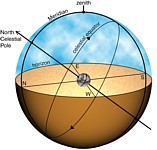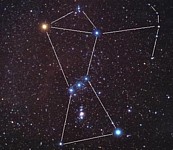2) This point and its opposite constitute geographical orientation points.
 By closely examining the apparent motion of stars around a particular point and comparing it with the phenomenon of "rising" and "setting" of the Sun, Moon and stars at another point on the horizon, it is possible to see that these points intersect with each other relatively, and determine 4 basic geographic orientations. A point from which astronomical objects emerge, another point from which they set, another point around which stars appear to rotate during the night, and the opposite point to this one. This allows establishing stellar orientation references, which if accompanied by extensive monitoring of stars and constellations (regions of several stars), makes it possible to determine their position at a certain time of the year.
By closely examining the apparent motion of stars around a particular point and comparing it with the phenomenon of "rising" and "setting" of the Sun, Moon and stars at another point on the horizon, it is possible to see that these points intersect with each other relatively, and determine 4 basic geographic orientations. A point from which astronomical objects emerge, another point from which they set, another point around which stars appear to rotate during the night, and the opposite point to this one. This allows establishing stellar orientation references, which if accompanied by extensive monitoring of stars and constellations (regions of several stars), makes it possible to determine their position at a certain time of the year.
Preliminary conclusion. Basic celestial orientation. Even for an observer who has not moved to another geographical location, or is lost in the cardinal points, simple observation allows determining the basic direction orientations on the Earth's surface. This supports the evidence of a rotational system, which can either be understood geocentrically (understanding the apparent motion of the stars rotating around the Earth) or by making the inverse association, that it is the Earth that rotates and makes it appear that they are the stars. the ones that do it.
3) There are regions of brighter stars that I can use to orient myself, and some coincide with the "band" where the Sun and Moon transit.
 Stars have always been distributed in the same way, at least in a way that can be considered "fixed stars," in contrast to celestial bodies like the Sun and the Moon, and "wandering" objects, the planets. By observing the night sky for several months, it is possible to notice areas with stars that are brighter and more noticeable than others. Even without knowing anything about modern constellations, an observer can easily invent his own "constellations," which are nothing more than regions of space with a group of stars that are "dominant" in brightness, which one can arrange in imaginary figures, or "asterisms." Supplementing this with the knowledge of the naturally discovered cardinal points, an observer will be able to use the constellations to orient himself in space and time, but will also notice that several of them are located just in that special "band" of the sky, which has already been identified as the path described by the Sun and the Moon.
Stars have always been distributed in the same way, at least in a way that can be considered "fixed stars," in contrast to celestial bodies like the Sun and the Moon, and "wandering" objects, the planets. By observing the night sky for several months, it is possible to notice areas with stars that are brighter and more noticeable than others. Even without knowing anything about modern constellations, an observer can easily invent his own "constellations," which are nothing more than regions of space with a group of stars that are "dominant" in brightness, which one can arrange in imaginary figures, or "asterisms." Supplementing this with the knowledge of the naturally discovered cardinal points, an observer will be able to use the constellations to orient himself in space and time, but will also notice that several of them are located just in that special "band" of the sky, which has already been identified as the path described by the Sun and the Moon.
Preliminary conclusion: Discovery/invention of constellations. Here we conclude the discovery of certain "patterns" in the stars according to their luminosity, as simple as a straight line formed by 3 stars, or a square formed by 4. This leads to the invention of the first constellations and imaginary figures (asterisms), whose purpose is simply to orient oneself in the night sky, with those located in the band that we know today as the ecliptic gaining special relevance.

